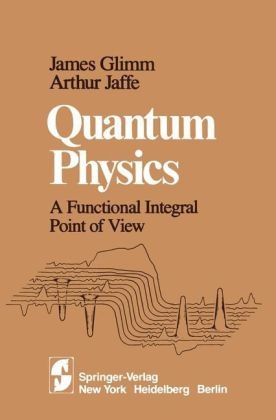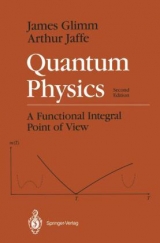
Quantum Physics
Springer-Verlag New York Inc.
978-0-387-90551-8 (ISBN)
- Titel ist leider vergriffen;
keine Neuauflage - Artikel merken
I An Introduction to Modem Physics.- 1 Quantum Theory.- 1.1 Overview.- 1.2 Classical Mechanics.- 1.3 Quantum Mechanics.- 1.4 Interpretation.- 1.5 The Simple Harmonic Oscillator.- 1.6 Coulomb Potentials.- 1.7 The Hydrogen Atom.- 1.8 The Need for Quantum Fields.- 2 Classical Statistical Physics.- 2.1 Introduction.- 2.2 The Classical Ensembles.- 2.3 The Ising Model and Lattice Fields.- 2.4 Series Expansion Methods.- 3 The Feynman-Kac Formula.- 3.1 Wiener Measure.- 3.2 The Feynman-Kac Formula.- 3.3 Uniqueness of the Ground State.- 3.4 The Renormalized Feynman-Kac Formula.- 4 Correlation Inequalities and the Lee-Yang Theorem.- 4.1 Griffiths Inequalities.- 4.2 The Infinite Volume Limit.- 4.3 ?4 Inequalities.- 4.4 The FKG Inequality.- 4.5 The Lee-Yang Theorem.- 4.6 Analyticity of the Free Energy.- 4.7 Two Component Spins.- 5 Phase Transitions and Critical Points.- 5.1 Pure and Mixed Phases.- 5.2 The Mean Field Picture.- 5.3 Symmetry Breaking.- 5.4 The Droplet Model and Peierls’ Argument.- 5.5 An Example.- 6 Field Theory.- 6.1 Axioms.- (i) Euclidean Axioms.- (ii) Minkowski Space Axioms.- 6.2 The Free Field.- 6.3 Fock Space and Wick Ordering.- 6.4 Canonical Quantization.- 6.5 Fermions.- 6.6 Interacting Fields.- II Function Space Integrals.- 7 Covariance Operator = Green’s Function = Resolvent Kernel = Euclidean Propagator = Fundamental Solution.- 7.1 Introduction.- 7.2 The Free Covariance.- 7.3 Periodic Boundary Conditions.- 7.4 Neumann Boundary Conditions.- 7.5 Dirichlet Boundary Conditions.- 7.6 Change of Boundary Conditions.- 7.7 Covariance Operator Inequalities.- 7.8 More General Dirichlet Data.- 7.9 Regularity of CB.- 7.10 Reflection Positivity.- 8 Quantization = Integration over Function Space.- 8.1 Introduction.- 8.2 Feynman Graphs.- 8.3 Wick Products.- 8.4 Formal Perturbation Theory.- 8.5 Estimates on Gaussian Integrals.- 8.6 Non-Gaussian Integrals, d = 2.- 8.7 Finite Dimensional Approximations.- 9 Calculus and Renormalization on Function Space.- 9.1 A Compilation of Useful Formulas.- (i) Wick Product Identities.- (ii) Gaussian Integrals.- (iii) Integration by Parts.- (iv) Limits of Measures.- 9.2 Infinitesimal Change of Covariance.- 9.3 Quadratic Perturbations.- 9.4 Perturbative Renormalization.- 9.5 Lattice Laplace and Covariance Operators.- 9.6 Lattice Approximation of P(?)2 Measures.- 10 Estimates Independent of Dimension.- 10.1 Introduction.- 10.2 Correlation Inequalities for P(?)2 Fields.- 10.3 Dirichlet or Neumann Monotonicity and Decoupling.- 10.4 Reflection Positivity.- 10.5 Multiple Reflections.- 10.6 Nonsymmetric Reflections.- 11 Fields Without Cutoffs.- 11.1 Introduction.- 11.2 Monotone Convergence.- 11.3 Upper Bounds.- 12 Regularity and Axioms.- 12.1 Introduction.- 12.2 Integration by Parts.- 12.3 Nonlocal ?j Bounds.- 12.4 Uniformity in the Volume.- 12.5 Regularity of the P(?)2 Field.- III The Physics of Quantum Fields.- 13 Scattering Theory: Time-Dependent Methods.- 13.1 Introduction.- 13.2 Multiparticle Potential Scattering.- 13.3 The Wave Operator for Quantum Fields.- 13.4 Wave Packets for Free Particles.- 13.5 The Haag-Ruelle Theory.- 14 Scattering Theory: Time-Independent Methods.- 14.1 Time-Ordered Correlation Functions.- 14.2 The S Matrix.- 14.3 Renormalization.- 14.4 The Bethe-Salpeter Kernel.- 15 The Magnetic Moment of the Electron.- 15.1 Classical Magnetic Moments.- 15.2 The Fine Structure of the Hydrogen Atom and the Dirac Equation.- 15.3 The Dirac Theory.- 15.4 The Anomalous Moment.- 15.5 The Hyperfine Structure and the Lamb Shift of the Hydrogen Atom.- 16 Phase Transitions.- 16.1 Introduction.- 16.2 The Two Phase Region.- 16.3 Symmetry Unbroken, d = 2.- 16.4 Symmetry Broken, 3 ? d.- 17 The ?4 Critical Point.- 17.1 Elementary Considerations.- 17.2 The Absence of Even Bound States.- 17.3 A Bound on the Coupling Constant ?phys.- 17.4 Existence of Particles and a Bound on dm2/d?.- 17.5 Existence of the ?4 Critical Point.- 17.6 Continuity of d? at the Critical Point.- 17.7 Critical Exponents.- 17.8 ? ? 1.- 17.9 The Scaling Limit.- 17.10 The Conjecture ?(6) ? 0.- 18 The Cluster Expansion.- 18.1 Introduction.- 18.2 The Cluster Expansion.- 18.3 Clustering and Analyticity.- 18.4 Convergence: The Main Ideas.- 18.5 An Equation of Kirkwood-Salsburg Type.- 18.6 Covariance Operators.- 18.7 Convergence: The Proof Completed.- 19 From Path Integrals to Quantum Mechanics.- 19.1 Reconstruction of Quantum Fields.- 19.2 The Feynman-Kac Formula.- 19.3 Self-Adjoint Fields.- 19.4 Commutators.- 19.5 Lorentz Covariance.- 19.6 Locality.- 19.7 Uniqueness of the Vacuum.- 20 Further Directions.- 20.1 The $$/phi _3^4 $$ Model.- 20.2 Borel Summability.- 20.3 Euclidean Fermi Fields.- 20.4 Yukawa Interactions.- 20.5 Low Temperature Expansions and Phase Transitions.- 20.6 Debye Screening and the Sine-Gordon Transformation.- 20.7 Dipoles Don’t Screen.- 20.8 Solitons.- 20.9 Gauge Theories.- 20.10 The Higgs Model and Superconductivity.
| Zusatzinfo | Bibliography |
|---|---|
| Verlagsort | New York, NY |
| Sprache | englisch |
| Gewicht | 800 g |
| Themenwelt | Sachbuch/Ratgeber ► Natur / Technik ► Garten |
| Mathematik / Informatik ► Informatik | |
| Mathematik / Informatik ► Mathematik | |
| Naturwissenschaften ► Physik / Astronomie ► Mechanik | |
| Naturwissenschaften ► Physik / Astronomie ► Quantenphysik | |
| ISBN-10 | 0-387-90551-0 / 0387905510 |
| ISBN-13 | 978-0-387-90551-8 / 9780387905518 |
| Zustand | Neuware |
| Haben Sie eine Frage zum Produkt? |
aus dem Bereich



